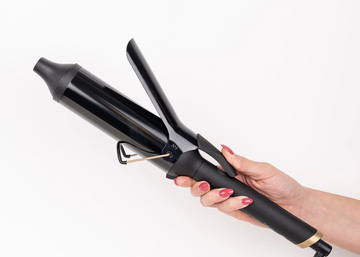Yes AND no—you’ll have to read on to find out!
Wig queens, we’ve all been there. One day you’re rocking sleek, straight vibes with clean girl energy, and the next, you’re dreaming of big, bouncy curls that scream Hollywood starlet. But if you’re working with a synthetic wig, you’ve probably hesitated before grabbing your curling iron. The burning question (pun fully intended)—can you actually curl a synthetic wig with a hot tool?
We’re sorry to say, synthetic wigs aren’t like human hair. They’re made from fibres that don’t exactly love heat—unless they’re specially designed to handle it. And let’s not sugarcoat it, either, using heat incorrectly on synthetic wigs can lead to melted disasters that look more oops than omg. But please DON’T panic, girlie. If you’re working with a heat-resistant wig or exploring heatless styling options, we’ve got all the answers (and hacks) you need to slay your wig game safely.
From figuring out if your wig can handle a curling iron to mastering heat-free curling methods (yes, we’re talking foam rollers and pin curls), this guide is here to save your wig and your look. So, grab your favourite styling tools, and let’s make those synthetic fibres curl to your will—literally.
Ready to level up your wig styling skills? Keep reading, because your next STUN-ning look is just a few steps away.
Hot tools and synthetic wigs—what’s safe, what’s not
Alright, let’s cut to the chase, shall we? Not all synthetic wigs are created equal, and when it comes to curling irons, the difference can make or break—literally—your style dreams. If you’ve ever wondered why some wigs sizzle under heat and others seem unbothered, here’s the 411.
First, the basics: traditional synthetic wigs are made from plastic fibres. Yep, you heard that right—plastic. And what does plastic do when it meets heat? It melts, girl. That’s why whipping out a curling iron on a non-heat-resistant wig is a recipe for heartbreak (and a crispy wig that’ll never recover).
Don’t despair! Enter heat-resistant synthetic wigs—a TOTAL game-changer. These beauties are designed to handle a certain level of heat (think 250°F to 350°F max). Still, even with heat-resistant wigs, it’s not a free-for-all. Always keep the temperature low and test on a small section before diving in headfirst. Your wig deserves as much TLC as your real hair.
So, how do you know if your wig is heat-safe? Check the label, always. It’s your wig’s way of telling you exactly what it can (and can’t) handle. No label? No problem. When in doubt, assume it’s not heat-friendly—it’s better to play it safe than risk frying your style dreams.
Oh, and even if you’ve got a heat-resistant wig, curling irons aren’t always the MVP. Heatless styling hacks (think flexi rods or pin curls) can give you perfect curls without the stress. Don’t worry, we’ll cover those lifesavers in the next section.
Moral of the story? Know your wig, respect its boundaries, and keep the drama reserved for your outfit—not your styling tools. Ready to curl smarter, not harder? Let’s talk heat-free magic.
How to curl a synthetic wig without heat
Time to ditch the heat and embrace some styling hacks that’ll keep your synthetic wig looking on-POINT without a single scorch mark. Whether you’re after soft waves, tight ringlets, or that “I woke up like this” look, these heatless methods have your back—and your wig fibres.
1. Foam rollers—the OG curl queen
For those classic, bouncy curls, foam rollers are the OG hair helper. Here’s how to nail it: start by detangling your wig with a wide-tooth comb (gently, please—no yanking!). Section the hair, roll each piece around a foam roller, and secure it in place. Let it sit overnight or for at least 6-8 hours. The result? Fluffy, defined curls that scream main character energy.
2. Flexi rods—the wave wizards
If loose, beachy waves are your thing, flexi rods are where it’s at. Wrap small sections of hair around the rods, bend the ends to lock them in place, and let them work their magic. The longer you leave them in, the more defined your waves will be. It’s giving dreamy goddess vibes, and we are here for it.
3. Braiding—simple and effortless
This one’s for all the low-maintenance girlies. Just section your wig, braid each part (the smaller the braid, the tighter the curl), and leave it overnight. In the morning, unbraid and fluff for the ultimate soft, wavy look. Top tip: spritz a little water on the wig before braiding to help set the shape.
4. Pin curling—a classic for a reason
Old-school, but oh-so-effective. Wrap sections of hair around your fingers, pin them flat to the wig cap, and leave them to set overnight. Once you release the pins, you’ll have stunning curls with zero heat damage. Bonus: it’s perfect for achieving that retro-glam look.
5. Headband wrap—the lazy-day lifesaver
For those who like their styling low-effort, this one’s for you. Wrap sections of hair around a soft headband and let them sit while you Netflix and chill. By the time you’re ready to slay, your wig will have soft, natural waves ready to go.
The best part about these methods? They’re not just wig-friendly—they’re TIME-friendly too. No need to stress about heat settings or melting fibres. Just set it, forget it, and wake up to curls that are ready to take on the day. And trust us, your wig will thank you for the extra care.
Feeling inspired yet? Let’s get into a more advanced wig hack—the hot water curling method.
Hot water curling—the ultimate wig hack
Ready to take your wig styling skills to the next level? Say hello to the hot water curling method—a tried-and-true trick that’s perfect for synthetic wigs. This technique doesn’t just create long-lasting curls, it’s also completely heat-tool-free, making it a safe bet for wigs that can’t handle direct heat. Let’s break it down step by step, babe.
Step 1—Prep your wig
Start by detangling your wig with a wide-tooth comb or your fingers. Make sure it’s clean and completely dry before styling—no one wants to fight through knots while curling. Divide the wig into sections, and decide on the curl size you want. Smaller sections mean tighter curls, while larger sections give you soft, loose waves.
Step 2—Heat the water
Boil a pot of water and let it cool slightly. You’re aiming for hot but not boiling—this is important, as boiling water can damage synthetic fibres. Pour the hot water into a large heat-safe container.
Step 3—Set the curls
Roll each section of hair onto foam rollers, perm rods, or even your trusty flexi rods, depending on the curl size you’re going for. Secure them in place, making sure everything’s tight and evenly distributed.
Step 4—The dip
Carefully dip each section of the wig (rollers and all) into the hot water for about 10-20 seconds. Use tongs or a similar tool to avoid getting too close to the heat. Don’t submerge the wig cap unless it’s heat-safe, as some materials may shrink or warp.
Step 5—Let it cool and set
Once you’ve finished the hot water dip, let the wig and rollers cool completely. This step is IMPORTANT—the cooling process locks the curls in place, so don’t rush it. You can speed things up with a blast of cool air from a fan, or just let it sit overnight.
Step 6—Release the curls
Gently remove the rollers, fluff the curls with your fingers, and watch the magic unfold. Spritz a light wig-specific styling spray if you want to keep the curls in place all day.
Final takeaway—are synthetic wigs made for heat? Best not.
Here's the bottom line, girl. When you’re thinking about synthetic wigs and heat, the safest answer is no. While heat-resistant synthetic wigs are a thing (and a lifesaver for styling versatility), not all wigs are built to handle the high temps of curling irons, straighteners, or blow dryers.
Traditional synthetic wigs? They’ll melt faster than a popsicle in the sun if exposed to heat, so it’s best to steer clear of hot tools altogether. Even if you’ve got a heat-friendly wig, it’s all about caution—low temperatures and testing small sections are a must to avoid turning your fabulous hairpiece into a frizzy mess.
BUT there is good news—synthetic wigs can look just as perf without heat! With all the heatless curling methods we’ve covered (hello, foam rollers, braids, and hot water dips), you’ve got plenty of ways to create jaw-dropping curls, waves, or volume while keeping your wig fibres in perfect condition.
The takeaway? If you’re unsure, skip the heat altogether and reach for heatless hacks instead. Your wig will last longer, look better, and save you a whole lot of stress. Hallelujah!





